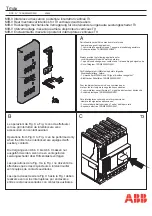
Effective 10/2004
Page 23
I.L. 70C1036H05
The installed rating plug must match the current sensors
which establish the maximum continuous current rating of
the circuit breaker (
I
n). Instantaneous and ground current
settings are defined in multiples of (
I
n).
To illustrate the effect of each protection setting, simulated
time-current curves are pictured on the face of the trip unit.
Should an automatic trip occur (as a result of the current
exceeding the pre-selected value), the LED in the appropri-
ate segment of the simulated time-current curve will flash
red, indicating the reason for the trip.
All Digitrip 1150 and Digitrip 1150
i
offer the LSI(G) curve as
the standard factory default. The five segment straight line
curve of LONG PU and Time, SHORT PU and Time, and
INSTantaneous PU are depicted on the nameplate of the
product. The GROUND (EARTH) element is shown also on
styles with Ground Fault Protection. The LSIA style has
Ground Alarm Only function
(See Appendix D12-D13).
A second curve selection is also possible for UL/ANSI
styles. An IEEE curve that accurately follows the Inverse-
Time characteristic equations can be selected (IEEE draft
PC37.112-11/95). Curve shapes of MODerately INVerse,
VERY INVerse or EXTremely INVerse are available under
PHASE SLOPE. Each of these curve shapes have a
PICKUP and TimeDIAL selection to position the curve. The
short delay function is included as part of IEEE curve.
For the Digitrip 1150
i
, a second curve type is also possible
for the international styles. An IEC curve type that accu-
rately follows the IEC255 curve equations can be selected.
The curve shapes of IEC-A (normal inverse), IEC-B (very
inverse) and IEC-C (extremely inverse) are available under
PHASE SLOPE. Each of these curve shapes have a
PICKUP and TimeDIAL selection to position the curve. The
short delay function is included as part of IEC curve.
The available settings, for the LSIG standard curve along
with the effects of changing the settings, are described
below and in Figures 4.1 through 4.8. Sample settings are
represented in boxes (e.g.
)
4.2.1.2 LONG SLOPE Setting
There is a I
2
t or I
4
t curve shape selection possible for
LONG SLOPE.
4.2.1.3 LONG PU Setting
There are thirteen available Long Delay Settings as
illustrated in Fig. 4.1. Each setting, called (
I
r), is ex-
pressed as a multiple (ranging from .4 to 1) of
the current
(I
n).
NOTE:
(
I
r) is also the basis for the Short Delay Current
Setting
(See Section 4.4).
Figure 4.1 Long PU Settings
4.2.1.4 LongTIME Setting
There are forty five available Long Delay Time Settings I
2
T,
as illustrated in Figure 4.2, ranging from 2 to 24 seconds.
For the I
4
t slope there are nine settings ranging from 1 to 5
seconds. These settings represent the total clearing times
when the current value equals six times (
I
r).
Figure 4.2 Long Delay Time Settings
NOTE:
In addition to the standard Long Delay Protection
Element, the Digitrip 1150 trip units using LONG SLOPE
settings of I
2
t or I
4
t also have a Long Time Memory (LTM)
function, which protects load circuits from the effects of
repeated overload conditions. If a circuit breaker is closed
soon after a Long Delay Trip, and the current again ex-
ceeds the Long Delay Setting, (
I
r), the LTM automatically
reduces the time to trip to allow for the fact that the load
circuit temperature is already higher than normal because
of the prior overload condition. Each time the overload
condition is repeated, the LTM causes the circuit breaker
to trip in a progressively shorter time. When the load
.4, .45, .5, .55, .6, .65
.7, .75, .8, .85, .9, .95, 1.0
Pu
2, 2.5, 3, 3.5,4, 4.5,…
22, 22.5, 23, 23.5, 24
Pu










































